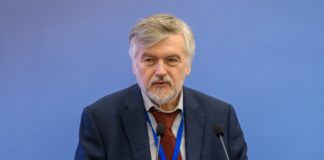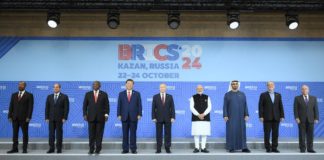 Russia’s leading economists, with the participation of reputable foreign experts, government officials and businessmen, defined at the Saint Petersburg Economic Congress, SPEC-2019 the areas of the country’s technological development in order to create a model of breakthrough economy.
Russia’s leading economists, with the participation of reputable foreign experts, government officials and businessmen, defined at the Saint Petersburg Economic Congress, SPEC-2019 the areas of the country’s technological development in order to create a model of breakthrough economy.
Breakthrough technologies
Today, the country’s civil society, businesses and politicians are concerned about breakthrough development. Technological breakthrough is being discussed at all levels, the National Technology Initiative project has been launched, however most experts believe it’s still a long way to go until breakthrough. Economists are actively involved in the discussions and are ready to assume the responsibility to advise on the proper development trajectory that will not lead into a dead end.
Academician Viktor Ivanter uses a strong expression to drive the idea home: «Excuse me, but all “reformers” might as well go to hell. Instead of reforms and reformers, we need people who can explain what exactly needs to be done and how to do it. It seems to me that if instead of discussing our problems we talked about our successes that can be replicated, and we’ve had those, and we could understand and explain how, with all the bad stuff that’s been happening in the economy, we’ve still managed to build the bridge and to revive the military-industrial complex and agriculture. That’s the proposal I have, and if it is accepted, I trust we will spend our time in a most effective manner.”
The entire global, not just Russia, is poised at the beginning of qualitative transformations that create global challenges for the future socio-economic development; a gradual transition has begun towards a new paradigm, towards re-industrialization and revival of industry on a qualitatively upgraded technological base. But given its actual pace, the transition, despite the appeals from on high, is still more words than deeds, a subject of discussions, says Professor Bodrunov, Director of the S.Yu. Witte Institute of New Industrial Development and President of the Free Economic Society of Russia.
“Those problems are on a completely different scale, one that’s more profound. We are just beginning to realize it. We at the Witte Institute have been have been working on those issues in tandem with scientists from the Russian Academy of Sciences for more than 20 years. In contrast to the various studies that are popular today, although they are not sufficiently conceptualized and oftentimes not even systematized, we offer a theoretical understanding of those trends, and we believe that the basis of all changes is the growth of knowledge-intensity of material production. Such knowledge-intensive progress needs integration of production, science and education, a trajectory based on high tech reindustrialization which creates a possibility of advanced (in the case of deriving our own proper knowledge) rather than catch-up development of the Russian economy», Bodrunov says.
Not a future-oriented policy
According to Academician Glazyev, a big issue of the Russian economy is that the methodology of foresight, or prediction of technological, institutional or social future, which is necessary for successful socio-economic development, is not in any way related to the actual economic policy. And hence the existence of an especially huge valley of death in Russia, the death of new technological ideas in the process of transition of knowledge from fundamental research to commercialization. The advanced countries are entering the phase of a new technological mode, which will generate a new long wave of development, and it will be especially difficult for us to enter that phase because of the valley of death, although to make a leap forward in its economic development the country will need a technological revolution, because the new mode implies a growth rate of 35%, and sometimes 70-80% per year, while the introduction of such technologies on the periphery will also result in an outpacing growth of 10-15% in the key industries.
“We’ve had some funding for fundamental research, albeit small if compared to other countries, but still noticeable. There are examples of commercialization of mostly imported technologies, and admittedly some of ours, but our technologies are unable to pass through the valley of death because there are no state support mechanisms. And so, we are stuck in reproducing what we have already created, and we lack proper economic policy tools to overcome the technological gap between the technological modes and to create a powerful drivers for economic growth. We simply do not use such tools,” says Glazyev.
Aganbegyan’s seven steps
Academician Abel Aganbegyan believes that drastic measures are needed to change the economic situation in Russia, and it became quite obvious in 2019 — one of the worst years in terms of socio-economic development. The grandmaster of Russian economics formulated seven steps that need to be taken in order to radically change the situation.
First step
Transition to forced investment and invest in human capital. At the same time, create mechanisms to increase consumer demand.
Second step
Mobilize considerable funds. What funds can be used? We have a gross domestic product worth almost 104 trillion rubles, and almost 18 trillion rubles in investments. We need 2 trillion a year to increase them by 10%, and we need 1.5 trillion to advance the knowledge-based economy by 10%. We need at least a couple trillion rubles a year to compensate for the decline in real incomes
Third step
Lower the key rate of the Central Bank to at least 4-5% over 3 years. So long as it’s not reduced, finance a lower rate from the budget to ensure technological upgrade of the existing production facilities, four percent for new high-tech industries, four percent for infrastructure.
Fourth step
Switch to stimulating investment and economic growth, introduce a tax break for technological upgrades and construction of new facilities, etc.
Fifth step
Major structural changes are needed in order to remove obstacles to economic growth and stimulate economic growth in the regions and at private companies. To that end, major transformations are needed in the field of property ownership: competitive environment should be restored, we need natural monopolies, we need to increase the share of private property to at least 50%.
Sixth step
Make fundamental changes in the banking and budget policies.
Seventh Step
Carry out serious social reforms which we’ve been carrying out the wrong way. This includes pension, health care, housing and utilities infrastructure.
Technologies and ecology
Technological development cannot be viewed in isolation from the environment. It is obvious. We have seen too many disasters caused by the technological development of the past eras. Nowadays, there’s much talk in the global community about a climate policy and climate issues. However, according to academician Boris Porfiryev, Director of the Institute of Applied Physics, Russian Academy of Sciences, if this topic is not carefully analyzed from all sides, it can turn into a negative factor for economic growth, considering what our partners are currently trying against us. Porfiryev recalls the words in the preamble of the Paris Agreement to the effect that the Parties may be affected not only by climate change, but also by the impacts of the measures taken in response to it.
“What are we being offered today as a medicine which has been extensively used for a while by the our economic authorities? The so-called low-carbon economy which implies that as soon as we have solved all our climate problems by minimizing greenhouse gas emissions, primarily carbon dioxide, we will start living happily ever after. To this end, an economic mechanism is proposed in the form of imposition of the so-called carbon tax, which is shamefacedly referred to as carbon fee. In particular, that is exactly what it looks like in the latest project of the Ministry of Economic Development which authored the draft laws regulating greenhouse gas emissions. The question is simple: will the transition to a low-carbon economy solve the climate stabilization problem, the problem of keeping the temperature change below 1.5 degrees until 2100 as proposed by the international community? The second question is whether it will helps to ensure the sustainability of economic development and economic safety. The answer to both of these questions is negative, and it is backed up by corresponding calculations made by international experts.”
At the same time, according to Porfiryev, other no less important mechanisms for solving the climate problem are being ignored, in particular, the need for adaptation, which is important regardless of whether and to what extent the problem of emissions will be solved.
Future is uncertain
According to Sergey Kalashnikov, a member of the Federation Council, Doctor of Economics, any forecasts currently proceed from the sequential logic that is characteristic of our thinking: new scientific achievements have been made, a new technological mode has emerged, and this new technological mode will give rise to a new economy. But Kalashnikov is convinced that linear logic does not apply in this case. What we really see is several different events occurring simultaneously in different areas. Kalashnikov believes there are already certain elements that over time are certain to grow into complex systems, by which we could judge the contours of the future, but, unfortunately, no certain knowledge is available at this stage, and only after those systems have taken shape will we understand what problems will require solution.
Outlines of future problems (according to S. Kalashnikov)
First
The nature of labor has changed: we are switching from processing stuff to processing information, and it immediately entails a complete transformation of the importance, role and nature of human labor. In any case, labor becomes network-based, personalized and creative. Today, a person as the creator of certain products becomes self-employed, and the entire production cycle can be run from beginning to end by a single individual or by a group of cooperating individuals.
Second
A creative person has different living conditions. A new type of economy is emerging, based on the proliferation of a service sector, and the emergence of a special class of services, social services. Colleagues, when you see a doctor, you do not have any defined set of parameters describing the quality of service you expect to receive, and neither does the doctor. When no quality parameters are assumed, the entire services pricing system starts to crack at the seams.
Third
New labor, new social conditions require a new organization of society. What lies on the surface is the aging of the population and, what’s more terrifying, mass unemployment. Considering the processes of robotization, computerization and so forth, tomorrow we will face the problem of millions losing their jobs. The most vivid example is the huge amount of people employed as car drivers. We already see that’s a job of yesterday.
Fourth
It all leads to a stratification of society, whether we like it or not. With our 20th century notions, how well are we prepared for a deep stratification of society and everything that goes with it? Do we need to remind ourselves of the political risks caused by deep stratification?
Fifth
Another example, the ineffectiveness of the old mechanisms of social protection. The social security system has been destroyed. The replacement of horizontal distribution with vertical, massive non-individualized contingencies, the inability to separate subjective and objective risks of insurance has rendered social insurance ineffective in all areas. As a result, there is a lack of basic social mechanisms, pension systems, health care, and education.
Sixth
The role of the state should be interpreted in a completely different way. Like it or not, the state has become the big brother we had been laughing so hard at by the end of the 20thcentury. We are not going anywhere without increasing the role of the state, and not only in the economy but primarily in the social sphere, because we need stronger controls in the new uncertain social situation.
Conclusions
In the existing circumstances, minimum social standards no longer work as a means of fighting poverty; for future use we need to switch to average social standards.
A new education system is a combination of algorithmic education of Jan Amos Comenius and classical education.
It will be necessary to revise the basic concepts of justice and equality. Currently, the concept of equality, which translates to the equality of conditions or opportunities, needs serious revision.
New models
According to Viktor Ivanov, Corresponding Member of the Russian Academy of Sciences, the existing model of socio-economic development has reached its limits. The question is what model we will use in the future.
«We have now come to an active phase of formation of a new environment. We’ve now switched to an active environment. The question is how it will happen. When we invent new technologies, we don’t know how they will be used. First we zoom out, then focus. The question is what we will focus on. If the focus lands on a positive zone, we will get a humanitarian and technological transition. If it lands on a negative zone we will end up with a catastrophe and degradation. How can we control the process? We’ve now practically come to the concept of humanitarian and technological revolution which prioritizes improvement of the quality of life based on new technologies,” Viktor Ivanov says.
Digital economy
Attention was also paid to digitalization which is much talked about but is not well understood. Elena Lenchuk, Director of the Institute of Economics of the Russian Academy of Sciences, says no generally accepted definition exists of digital economy so far, either in scientific literature or in the programs. Moreover, in principle, digital economy as a controlled entity, or even a strategically controlled entity, has yet to be defined. However, foreign economists define “digital economy” as a combination of information and communication technologies with bio-, cognitive, and physical technologies.
“Today, a large-scale digital transformation is taking place abroad, the size of the global digital sector today is up to 15% of the global GDP. According to estimates, it will grow in size to $23 trillion by 2035. In that sector, companies’ capitalization exceeds that of energy companies, telecommunications giants, and we cannot ignore this fact. Russia, of course, lags behind the digital economy leaders in many respects. According to various estimates, we are 5-8 years behind. In this regard, it is interesting to look up the global digitalization index. At this point, Russia ranks 42nd, even behind Kazakhstan,” says Elena Lenchuk.
According to the scholar, without launching the digitization process, without developing technologies, the targets set by the May decree, No. 204, which provide for a several times increase in productivity, growth of non-commodity exports and development of innovatively active enterprises, will be practically unreachable. And one should ask oneself whether the measures prescribed by the Digital Economy national project are sufficient to turn digitalization into a driver of economic growth. Today, 70% of the software used in Russia is foreign made, and there’s a disastrous lag in microelectronics. Therefore, according to Lenchuk, the creation of a digital economy in our country first of all implies an overall general technological modernization of all areas and is only possible with the creation of an innovative development model and the introduction of advanced production technologies of a new technological mode.
Dmitry Belousov, a prominent analyst from the Center for Macroeconomic Analysis and Short-term Forecasting, followed up on the topic of digitalization. In his opinion, it’s more important that digitization creates new conditions for all major production factors: on one hand, one can lift the curse of being tied to the customary suppliers, on the other hand, one can work directly for the global market becoming directly involved in the global commodity exchange network. The contribution of the IT sector in GDP may account for a 0.4% growth, which is 10% of what we can realistically count on today.
“A decision on developing a digital economy should also be a decision on stimulating economic growth, otherwise we simply won’t be able to provide jobs for those people who will become unemployed as a result of digitalization; and also a decision on developing mass industry, otherwise digitalization will become the story of individual firms operating in foreign markets over and above our economy; and also a decision on increasing territorial, professional, and other mobility. That’s the problem we are running away from. Digitalization generates long-term social and political challenges that have yet to be properly understood. Only now are we beginning to understand that digitalization makes it possible to develop minimum-manned production. For instance, the Amur Gas Chemical Complex, a huge global facility which is currently under construction, will employ 1,200 people, a staff of a medium-sized plant in the Soviet Union. And near zones of intensive growth zones of decline are likely to emerge,” the expert warns.
R&Dparadox
Viktor Ryazanov, Head of the Economic Theory Department at the St. Petersburg State University drew attention to the fact that despite the increase in research and development spending and the several times growth of the new technologies – nanotechnology, computer technology, and biotechnology – labor productivity continues to fall, and the forecasts are far from being optimistic.
“The question is why the period, as large as it was, of the development of R&D and the new industrial revolution did not yield any impressive results? I think that it’s quite appropriate to remember Marx and his law of correspondence of productive forces to the level and the character of development of production relations. Therein lie the main limitations that prevent research projects and new technologies from being successfully implemented in the economy. Indeed, if we take a closer look, we will see that, naturally, a speculative economic model cannot ensure that sufficient financial resources will be rerouted for supporting and distributing new technologies.” the scholar said.
Fundamental answers
Concluding the SPEC-2019 plenary session, Dmitry Sorokin, Corresponding Member of the Russian Academy of Sciences, Research Director of the Financial University under the Government of the Russian Federation, and Research Director of the VEO of Russia, remined the audience that however they described the emerging trends – continued stagnation or recovery from the crisis — so far according to the 2018 official results the volume of investments is lower in real terms than in 2012, the processing industry in the conditions of import substitution ended up on the 2012 level, the volume of construction work is below the 2010 level, and real disposable incomes of the population are the same as in 2010.
“I remember all too well an article in Rossiiskaya Gazeta, a column brilliantly written by Viktor Ivanter. And he clearly stated some 5 months ago that the development projections and plans that had been submitted did not envisage the fulfillment of the presidential decree on ensuring a breakthrough development, either technological or socio-economic,” the scholar stressed. “I wouldn’t really want all those discussions, deliberations and debates to boil down to a talk about the mistakes made by the government, the politicians, and so on. I would like us to look for fundamental answers to the questions, to look into the patterns of our existence in search of what the recent speakers were referring to. It would be better for science that way.”
New enterprise structure
Georgiy Kleiner, Deputy Research Director of the Central Institute of Economics and Mathematics of the Russian Academy of Sciences, Corresponding Member of the Russian Academy of Sciences
There’s no doubt a federal program for reforming the enterprise should be established. There’s no reason to expect that enterprises will adapt on their own. The range of legal forms of the enterprise should be expanded. The current range is obviously too narrow to encompass all relationships among owners, managers, employees and specialists. Certain formats, the so-called collective forms, should be added to include establishment of self-managed enterprises. What does a company’s interior consist of? A sector of innovative projects, a sector of organizational structures, a sector of information and communication infrastructures, and a logistics and innovation sector. Those 4 sectors are currently not reflected in the management structure of the enterprise. I propose to create 4 offices in enterprises: a project office, a processing office, an organizational office, and an infrastructural or environmental office. Like barrel hoops, those 4 offices should draw together separate fragments, separate segments, separate areas of an enterprise’s activity, shaping the enterprise into a complete, balanced and effective system in a friendly external environment.
Economy of «successful psychopaths»
Yakov Mirkin, Head of the Department of International Capital Markets at the Primakov National Research Institute of World Economy and International Relations of the Russian Academy of Sciences, Doctor of Economics, Professor
In the US, there is a concept of the so-called «successful psychopath.» It’s sort of a normal person with despotic character traits, a winner. Such people are heads of corporations or presidents. If you think about it, the model of collective behavior of the managing class fits entirely into the successful sociopath concept. And what kind of economy is built around this model of collective behavior? First of all, it’s not a welfare economy, it’s an economy of barrels and megawatts. It’s based on the thieving, dishonest, manipulated, indoctrinated individual. The result is an economy of punishment, full of rules, an economy of vertical power, of super-concentration, of nationalization, a centripetal economy, and, in the end, a weird economy where growth is entirely supported by the budget. Any industrialist who you might happen to talk to at this point in time will not be talking about foreign investments or loans, which are expensive and inaccessible; he will be talking about budget preferences. If you think about it, it’s just a crazy growth model, doomed to failure in advance, because it makes the budget responsible for everything: war and peace, huge reserves and investment, defense and social spending.
Unpopular economy
Vitaly Tretyakov, Dean of the Higher School of Television of the Moscow State University, Professor
The inability to get a common-sense understanding of what is happening in our economy annoys people. Hence, the obvious demand for social justice. Meek attempts to put the problem in a spotlight and mitigate it seem rather cynical, hypocritical and sanctimonious. As Stalin’s popularity grows, ordinary people are questioning the equity in our today’s economy. When people who bash the Soviet economy, the Soviet system, the Soviet regime, and especially the Stalinist regime the most personally extract the maximum profit for themselves from what was built by the so-called “gulag slaves”, one cannot help asking: “Is it even fair you own it?” It’s a popular sentiment and it’s growing, a cry out for universal justice on the national scale, a feeling that the economy has not been built properly, that everything is being done in the interests of a very small group of people, not a middle class, not even the ruling class, but a tiny group within the ruling class. There’s no clue as to where we’re going, there’s little understanding even in the academic circles. People keep asking the same question. They do not understand their place in the economy.



